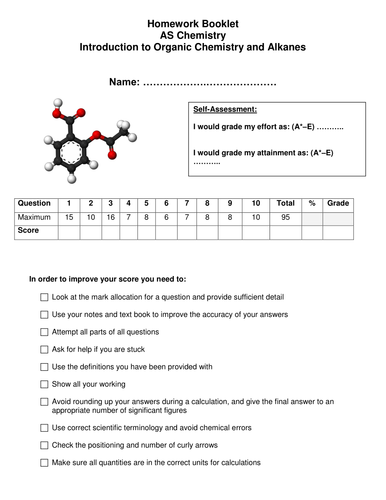






Using the specification and books
No exam questions are included due to copy right
Including:
Homework booklets
Assessment sheets
Interactive powerpoints (rarely seen in A-level)
Alkane
1. Introduction to alkanes (naming recap, crude oil and properties)
2. Fractional distillation (crude oil, fractional distillation, separation, uses, properties)
LESSON 1:
Objectives:
To state the definition of an alkane
To explain how alkanes are named
To describe the properties of alkanes
LESSON 2:
Objectives:
To state the origin of crude oil and the compounds contained within it
To understand how fractional distillation works
To be able to identify the differences between each fraction
ENJOY!!!
Please rate and comment in order to further improve
Get this resource as part of a bundle and save up to 35%
A bundle is a package of resources grouped together to teach a particular topic, or a series of lessons, in one place.
AQA AS level Unit 3 Section 2 Alkanes and Haloalkanes
AQA AS level Unit 3 Section 2 Alkanes and Haloalkanes Using the specification and books No exam questions are included due to copy right Including: Homework booklets Assessment sheets Interactive powerpoints (rarely seen in A-level) Alkanes section 1. Introduction to alkanes (naming recap, crude oil and properties) 2. Fractional distillation (crude oil, fractional distillation, separation, uses, properties) LESSON 1: Objectives: To state the definition of an alkane To explain how alkanes are named To describe the properties of alkanes LESSON 2: Objectives: To state the origin of crude oil and the compounds contained within it To understand how fractional distillation works To be able to identify the differences between each fraction LESSON 3: Objectives: To know what cracking is To compare the conditions and products of THERMAL and CATALYTIC cracking To know the economic reasons for cracking LESSON 4: Objectives: To recall what happens in complete combustion To recall what happens in incomplete combustion To know the problems associated with the internal combustion engine LESSON 5: To understand how pollutant emissions can be reduced To recall what happens in the greenhouse effect To consolidate learning with questions Haloalkane 1. Formation of haloalkanes from alkanes - chain reactions 2. Haloalkanes introduction 3. Nucleophillic substitution 4. Elimination 5. Ozone and CFC LESSON 6: FROM ALKANE SECTION Objectives: To define what a radical is To describe the reaction mechanism for free radical substitution of methane To understand that there can be other products of a chain reaction LESSON 1: FROM HALOALKANE SECTION Objectives: To recap how to name the haloalkanes To understand the properties To understand the reactivity of the C-X bond by using bond polarity and bond enthalpy LESSON 2: To understand what nucleophiles are To understand what nucleophilic substitution is To be able to give examples of nucleophilic substitution reactions LESSON3: To understand what an elimination reaction is To understand when conditions favour elimination rather than substitution To understand when and how isomeric alkenes are formed LESSON4: To understand the role of ozone in the atmosphere To understand how chlorine free radicals can be formed in the atmosphere and how they destroy ozone To explain how research evidence led to the end of use of CFCs and alternatives found
AQA AS level Unit 3: Organic Chemistry COMPLETE LESSONS package - alkane, alkene, halo, alcohols, analysis, intro to organic chemistry
AQA AS level Unit 3 Section 1 Introduction to Organic Chemistry AQA AS level Unit 3 Section 2 Alkanes and Haloalkanes AQA AS level Unit 3 Section 3:: Alcohols and Alkenes AQA AS Level Unit 3 Section 4 Organic analysis: Infrared, High resolution mass spec, Required prac 6- test tube reactions Introduction of Organic Chemistry 1. Introduction to carbon compounds 2. Nomenclature 3. Nomenclature part 2 4. Isomerism - Structural isomerism a) chain b) position c) functional 5. Isomerism - Stereoisomerism a) E/Z isomers Alkanes section 1. Introduction to alkanes (naming recap, crude oil and properties) 2. Fractional distillation (crude oil, fractional distillation, separation, uses, properties) Haloalkane 1. Formation of haloalkanes from alkanes - chain reactions 2. Haloalkanes introduction 3. Nucleophillic substitution 4. Elimination 5. Ozone and CFC Alkenes section 1. Introduction to alkenes 2. Electrophilic addition 3. Additional Polymerisation 4. Mechanism recap Alcohol section 1. Alcohol recap (if studies SS) or Introduction to alcohols 2. Oxidation of alcohols and practicals 3. Elimination 4. Required practical 5 Organic analysis section 1. Required practical 6 2. High resolution mass spectrometry 3. Infra-red spectrometry For more detailed lesson briefs see each individual section Includes all answers worksheets homework assessments Enjoy Saving 9%
Something went wrong, please try again later.
Fantastic lesson resources
Report this resourceto let us know if it violates our terms and conditions.
Our customer service team will review your report and will be in touch.
